Disclosure: Quarto Knows sent me a copy of this book in exchange for an honest review. All opinions are my own.
As much as I love Native Americans, I tend to stick to the Wampanoag. Perhaps it is because they live in Massachusetts or because they are the ones in the "first Thanksgiving" story. Plus they are often the ones I see displays about or meet because of the locality. Well I already wrote a post about the Wampanoag for Multicultural Kid Blogs for our Native American Heritage Month Series this year and several over the years here, so today I decided to look at another tribe, the Shoshone. I am going to review one of the books that is a prize in our giveaway and take a look at one of the most famous Native Americans--Sacagawea and her tribe the Shoshone. Last month I had the pleasure of sharing another book that is one of our prizes--I Am Sacagawea by Brad Meltzer. I also reviewed a book about Sacagawea a few years ago. Today's book is Path to the Pacific: The Story of Sacagawea by Neta Lohnes Frazier.
I have to say the more I learn about Sacagawea the more amazed I am by her life. Path to the Pacific goes into so many details including the various versions of what historians think about her life. Very little is known about Sacagawea's childhood. We know around the age of 12 she was taken by an enemy tribe, the Hidatsa. She was a servant to Hidatsa man but he treated her the same as he treated his own daughters. She also had a Shoshone friend with her. It is not even known when she was given the name Sacagawea (and there are many different spellings including Sakakawea). However Neta theorizes that it was the Hidatsa who named her since Sacagawea would translate to bird woman in their language. Some Shoshone claim the name is from their language with the meaning of "she who pulls boats". The Hidatsa man lost Sacagawea as well as her friend, Otter Woman, in a gambling game to Frenchman Toussaint Charbonneau. He had taken on some of the Native American ways including polygamy. He eventually married both Sacagawea and Otter Woman even though he had another wife. He had children with both Sacagawea and Otter Woman, and he favored Otter Woman. However when Meriwether Lewis and William Clark saw the benefits of having Sacagawea join their team--her knowledge of more languages as well as her not having a disability. Otter Woman suffered from a common Shoshone issue with her legs. Even though 16-year-old Sacagawea was pregnant, she was the one chosen.
What we know about Sacagawea is from the journals of the men on the expedition. She is not mentioned very often. Apparently her son, Jean Baptiste or Pomp as Clark nicknamed him, did not cause issues. There were not complaints about traveling with an infant. Sacagawea had him on her back in a cradleboard through most of the journey. She breastfed him. At night she would care for him--clean him and get him to sleep. Most of the mentions of Sacagawea have to do with the ways she helped the expedition. When the boat she was in almost capsized, it was Sacagawea with Pomp on her back that thought to rescue some of the important equipment that fell into the water while the men panicked. When food was hard to find, it was Sacagawea who knew where to look and what was safe to eat.
What I find so fascinating is the details in Path to the Pacific. I thought I knew most of what there was to know about Sacagawea, but this book makes me learn more as well as feel like it is a more personal story. I feel like I am getting to really know Sacagawea. I can only imagine what it was like to be taken as a slave and then left behind when other slaves were able to escape because she chose to stay with her friend Otter Woman. Then to be lost by her master due to gambling. Then being forced to marry the new master when another man had shown interest in her. To be forced to take her newborn son on an expedition with white men where no one speaks her language and there are no other women. Plus she is the youngest besides her baby. She has to keep her son quiet and not let him bother the men. Can you imagine? All the while in a boat or walking through woods and experiencing all kinds of challenges from extreme weather, illness and hunger. Then giving her son to Clark to have him educate and raise him and when she dies shortly after the birth of her daughter Clark takes her in as well. Reading this book made me want to learn more about the Shoshone, so I did some research for you and myself. Here are 10 interesting facts.
This post is part of the Multicultural Kid Blogs Native American Heritage Month Series and Giveaway!! Good luck in the giveaway!! For more of my Native American posts including other reviews of some of the prizes, be sure to check out here.
Welcome to our fourth annual celebration of Native American Heritage Month! All month long we'll be sharing posts about sharing these rich cultures with kids. Find our full schedule of posts below, and don't forget to link up your own as well! We're also having a giveaway (details coming soon!) Don't miss our series from last year, 2015, and 2014, plus you can find even more ideas on our Native/Indigenous Cultures Pinterest board: Follow Multicultural Kid Blogs's board Native/Indigenous Cultures on Pinterest.
November 3
Tiny Tapping Toes on Multicultural Kid Blogs: Jingle Dress Dancing
November 6
Crafty Moms Share on Multicultural Kid Blogs: 10 Fun Facts about the Wopânâak (Wampanoag) Nation
November 10
Mama Tortuga: Kevin Locke and the Hoop Dance of the Lakota
November 13
Crafty Moms Share
November 15
La Clase de Sra. DuFault
November 17
Kid World Citizen on Multicultural Kid Blogs
November 20
All Done Monkey
November 24
Discovering the World Through My Son's Eyes on Multicultural Kid Blogs
November 27
Creative World of Varya



a Rafflecopter giveaway
As much as I love Native Americans, I tend to stick to the Wampanoag. Perhaps it is because they live in Massachusetts or because they are the ones in the "first Thanksgiving" story. Plus they are often the ones I see displays about or meet because of the locality. Well I already wrote a post about the Wampanoag for Multicultural Kid Blogs for our Native American Heritage Month Series this year and several over the years here, so today I decided to look at another tribe, the Shoshone. I am going to review one of the books that is a prize in our giveaway and take a look at one of the most famous Native Americans--Sacagawea and her tribe the Shoshone. Last month I had the pleasure of sharing another book that is one of our prizes--I Am Sacagawea by Brad Meltzer. I also reviewed a book about Sacagawea a few years ago. Today's book is Path to the Pacific: The Story of Sacagawea by Neta Lohnes Frazier.
I have to say the more I learn about Sacagawea the more amazed I am by her life. Path to the Pacific goes into so many details including the various versions of what historians think about her life. Very little is known about Sacagawea's childhood. We know around the age of 12 she was taken by an enemy tribe, the Hidatsa. She was a servant to Hidatsa man but he treated her the same as he treated his own daughters. She also had a Shoshone friend with her. It is not even known when she was given the name Sacagawea (and there are many different spellings including Sakakawea). However Neta theorizes that it was the Hidatsa who named her since Sacagawea would translate to bird woman in their language. Some Shoshone claim the name is from their language with the meaning of "she who pulls boats". The Hidatsa man lost Sacagawea as well as her friend, Otter Woman, in a gambling game to Frenchman Toussaint Charbonneau. He had taken on some of the Native American ways including polygamy. He eventually married both Sacagawea and Otter Woman even though he had another wife. He had children with both Sacagawea and Otter Woman, and he favored Otter Woman. However when Meriwether Lewis and William Clark saw the benefits of having Sacagawea join their team--her knowledge of more languages as well as her not having a disability. Otter Woman suffered from a common Shoshone issue with her legs. Even though 16-year-old Sacagawea was pregnant, she was the one chosen.
What we know about Sacagawea is from the journals of the men on the expedition. She is not mentioned very often. Apparently her son, Jean Baptiste or Pomp as Clark nicknamed him, did not cause issues. There were not complaints about traveling with an infant. Sacagawea had him on her back in a cradleboard through most of the journey. She breastfed him. At night she would care for him--clean him and get him to sleep. Most of the mentions of Sacagawea have to do with the ways she helped the expedition. When the boat she was in almost capsized, it was Sacagawea with Pomp on her back that thought to rescue some of the important equipment that fell into the water while the men panicked. When food was hard to find, it was Sacagawea who knew where to look and what was safe to eat.
 |
| Lewis & Clark at Three Forks By Creator:Edgar Samuel Paxson (Personal photograph taken at Montana State Capitol) [Public domain], via Wikimedia Commons |
What I find so fascinating is the details in Path to the Pacific. I thought I knew most of what there was to know about Sacagawea, but this book makes me learn more as well as feel like it is a more personal story. I feel like I am getting to really know Sacagawea. I can only imagine what it was like to be taken as a slave and then left behind when other slaves were able to escape because she chose to stay with her friend Otter Woman. Then to be lost by her master due to gambling. Then being forced to marry the new master when another man had shown interest in her. To be forced to take her newborn son on an expedition with white men where no one speaks her language and there are no other women. Plus she is the youngest besides her baby. She has to keep her son quiet and not let him bother the men. Can you imagine? All the while in a boat or walking through woods and experiencing all kinds of challenges from extreme weather, illness and hunger. Then giving her son to Clark to have him educate and raise him and when she dies shortly after the birth of her daughter Clark takes her in as well. Reading this book made me want to learn more about the Shoshone, so I did some research for you and myself. Here are 10 interesting facts.
The Shoshone
- The Shoshone are divided into three main areas: Northern, Eastern and Western. The Northern Shoshone are near Snake River in present day Idaho and Western Wyoming. The Eastern Shoshone live in the valleys of Green River and Wind River, in the Rocky Mountains and near Yellowstone Lake. They are called the Wind River Shoshone. The Western Shoshone were found mostly in present day Nevada and parts of Utah and California. Sacagawea was a Northern Shoshone.
- The Northern and Eastern Shoshone hunted buffalo for food and clothing. They were introduced to horses in the late 1600s which helped them with travel and hunting.
- All of the Shoshone were nomadic. The harsh environment forced them to move for food. Since they hunted larger game, they could use animal skins for their dwellings and lived in tipis. The Western Shoshones lived in grass huts. They gathered rice, and hunted fish, birds and rabbits.
- The Shoshone wore clothing made from animal skins and some were decorated with beads or porcupine quills. Men wore leggings and breechcloths. They added shirts in the cooler weather. The women wore long deerskin dresses. In the summer the clothing was minimal. Women wore aprons. Both men and women wore moccasins. Headdresses were worn and decorated with a variety of feathers.
- Shoshone are known for their beautiful beadwork. In earlier times beads were made from seeds, animal teeth or bones. Today they are made from cut glass and sometimes pottery. They also have a history of painting on animal skins.
- The Shoshone call themselves Newe (nuh-WUH) which means the people.
- They participated in several ceremonial dances like the sun dance, a religious festival that took place in the summer, and the Buffalo Dance where women played the part of buffalos mostly for entertainment.
- Lewis and Clark were probably the first white men the Shoshone ever met. Lewis and Clark’s exploration brought new settlers. The Shoshone began to steal from settlers and raid wagon trains. Fighting between whites and Shoshones increased. When a group of Shoshone attacked settlers in Utah, the US soldiers attacked back in January 1863. The Shoshone were asleep near the modern border between Idaho and Utah. The Shoshone fought back but were outnumbered. More than 250 Shoshone were killed including women and children. This event is called the Bear River Massacre. It was the largest number of Native American deaths from one attack.
- In 1868 the Wind River Reservation for the Eastern Shoshone and the Fort Hall Reservation for the Northern Shoshone were established. In 1875 the Lemhi Valley Reservation was established. In 1905 the Shoshone Trail of Tears takes place as they are forced to move to the Fort Hall Reservation.
- Today there are between 30,000 and 40,000 Shoshone in the United States. About 1000 still speak their native language. Many live on reservations where they have their own governments. Most tribes no longer have chiefs but have an elected group of leaders. Some Shoshone tribes are not federally or nationally recognized.
 |
| Shoshoni Tipis By W. H. Jackson - http://loc.gov/pictures/resource/cph.3c15466/, Public Domain, Link |
 |
| Beaded Moccasins By Durova (Own work) [GFDL or CC BY-SA 4.0-3.0-2.5-2.0-1.0], via Wikimedia Commons |
 |
| Shoshone Indian Sun Dance at Fort Hill Reservation By Unknown or not provided (U.S. National Archives and Records Administration) [Public domain], via Wikimedia Commons |
Sources
- McDaniel, Melissa. Great Basin Indians. Heinemann Library. Chicago. 2012
- Native American Indian Facts Authors. Shoshone Tribe Facts. http://native-american-indian-facts.com/Great-Basin-American-Indian-Facts/Shoshone-Tribe-Facts.shtml
- Rajczak, Kristen. The Shoshone People. Gareth Stevens Publishing. New York. 2015
- Warpaths 2 Peace Pipes Authors. Shoshone Tribe. https://www.warpaths2peacepipes.com/indian-tribes/shoshone-tribe.htm
This post is part of the Multicultural Kid Blogs Native American Heritage Month Series and Giveaway!! Good luck in the giveaway!! For more of my Native American posts including other reviews of some of the prizes, be sure to check out here.
Welcome to our fourth annual celebration of Native American Heritage Month! All month long we'll be sharing posts about sharing these rich cultures with kids. Find our full schedule of posts below, and don't forget to link up your own as well! We're also having a giveaway (details coming soon!) Don't miss our series from last year, 2015, and 2014, plus you can find even more ideas on our Native/Indigenous Cultures Pinterest board: Follow Multicultural Kid Blogs's board Native/Indigenous Cultures on Pinterest.
Native American Heritage Month Giveaway

Grand Prize
From MotherTongues: Himdag T-shirt, women’s or unisex, S-XL, US/Canada Shipping Only From Abrams Books: Puritan Girl, Mohawk Girl, Red Cloud, Sitting Bull, Buffalo Bird Girl, In the Footsteps of Crazy Horse, and The Star People, US/Canada Shipping Only
1st Prize
From Wisdom Tales Press: Children of the Tipi: Life in the Buffalo Days, Indian Boyhood: The True Story of an Indian Upbringing, Whispers of the Wolf, Horse Raid: The Making of a Warrior, US Shipping Only




